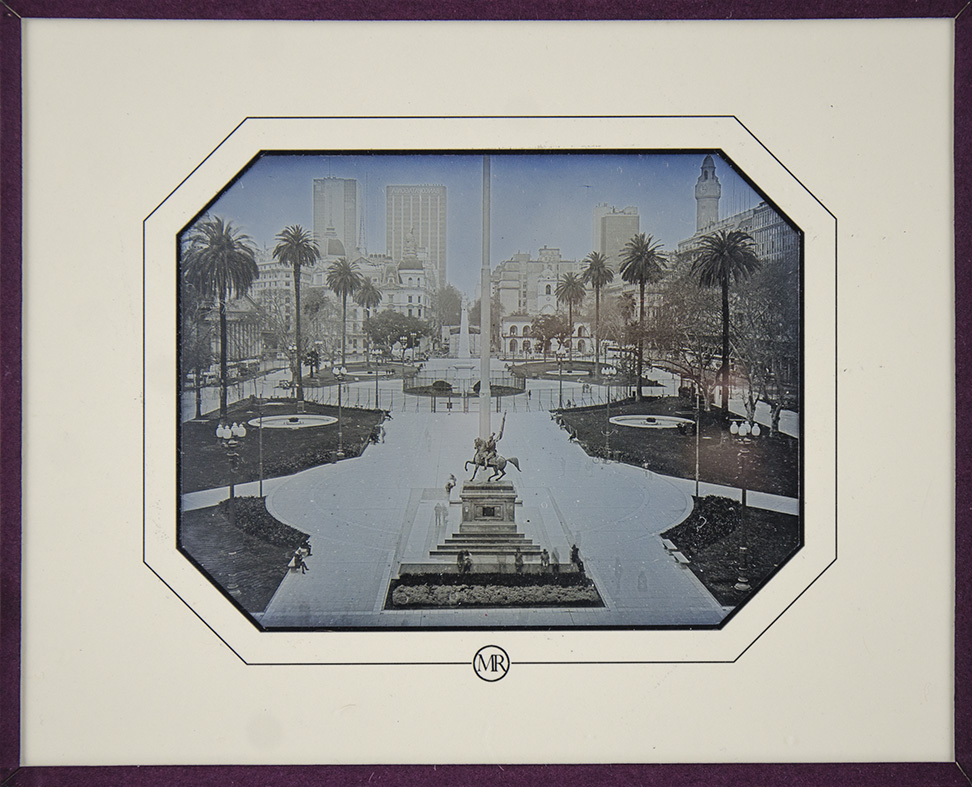Plaza de Mayo, seen from the presidential balcony of the Government House. Buenos Aires. 2019.
Contemporary daguerreotype, rectangular, measures: 9.5 x 12.5 cm / 3.74 x 4.92 in. Work framed with an openwork octagonal mat, with black trim and the monogram “M. R. ”, by authorship.
When the first photographic procedure -the daguerreotype- arrived in Buenos Aires in the middle of the year 1843, the today called Plaza de Mayo (1) was photographed by different professionals who worked in the city; only one of them signed by Charles DeForest Fredricks. Of those original records, nine daguerreotypes are preserved in the National Historical Museum, six correspond to the Plaza de Mayo in its different angles, and only one shows the Cabildo, unfortunately today very damaged, from 1852. Since that date, the Plaza de Mayo underwent numerous changes, such as the demolition of the Old Recova to unify both squares. The Cabildo building is the one that underwent the most changes throughout those years, first its tower was raised, then three of its arches on the right side were shortened, the tower was demolished and without it, three arches on the left side were removed (already in the 20th century) and finally, the tower was rebuilt in the viceregal way of its origin, together with the restoration of the entire building, in a work directed by the architect Buschiazzo. Its side arches were demolished to make way first for Avenida de Mayo and later, Avenida Julio A. Roca.
On the 180th anniversary of the public presentation of photography in Paris, which came to revolutionize the visual culture of humanity through the daguerreotype technique, Canadian artist Mike Robinson was specially invited by historian Carlos Vertanessian, to photograph the historical plaza, and reissue the practice of those Darregotypists who visited the city in the 1850s. This was the first time in history that shots of the Plaza de Mayo were made from the location where the Government House is located today, but that then, it corresponded to the Fort of Buenos Aires. Given the relevance of the event, and mediating an official authorization, Robinson placed his camera on the material railing of the presidential balcony of the Government House, to "print" the image on the silver copper plate of the daguerreotype. The development was carried out in the office next to the balcony, to certify that this and a few other shots, taken that day, with different perspectives, have been a success.
We see that the image is presented laterally inverted, characteristic of this technique in its first stage. The image shows the unmistakable tower of the Legislative Palace and the Cabildo front on the right, while the City Government Palace and the Cathedral are located on the left. As a result of the long time required for the capture, we appreciate how the intriguing "phantasmagorias" were embodied, before the passing of the circumstantial passers-by. Likewise, the palm trees planted by Domingo F. Sarmiento and Torcuato de Alvear in 1882, which were brought from Rio de Janeiro, are observed. In vintage photographs, they are observed of little stature, however, here, after more than a century, they stand stately and as imposing plant monuments, silent witnesses of the vicissitudes of the country's history.
As a direct camera positive and a single original, it does not provide the ability to make copies. We are thus, in front of a unique piece, for which this image, like all quality daguerreotypes, is imbued with the aura of works of art, and has a hierarchy superior to other types of photographic techniques. Dr. Mike Robinson is a master -in the broad sense of the word- of contemporary artistic daguerreotype, and is among the few who have mastered the technique as an expressive medium, giving his works both an artistic and historical character. The daguerreotype is a unique piece, essentially a very brief edition of one, and Robinson's work is characterized by a rare combination and sense of classical beauty, with a high level of technical skill, both required to be successful in an environment characterized by its unmatched image quality and permanence. His works are in the main public museums and private photography collections in the world.
For more information on Mike Robinson: https://centurydarkroom.com/abp
Notes: 1. Divided at that time into Plaza de la Victoria and Plaza 25 de Mayo, until in 1884 it changed its appearance and name.
| AUTHOR | MIKE ROBINSON |
|---|---|
| ITEM | 16 |
Are you interested in selling some works?
Send us an email briefly indicating
which works you intend to put on sale, and we will respond. click here
Subscribe to our newsletter to be updated.
Check our Newsletters